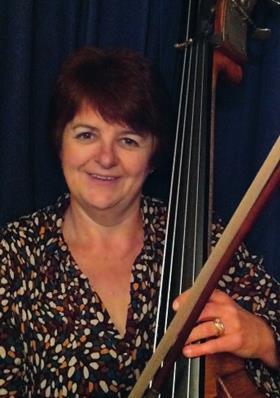The Cardiff-based double bass pedagogue explains why her students’ health is her biggest concern, in this interview from April 2012

What ages and standards do you teach?
I teach both children and adults from beginner standard through to conservatoire level. I love teaching adults because they have such a thirst for knowledge. What you say can open up a whole new world for them and they really appreciate your help. Youngsters tend to take it for granted that you’re there to teach them, but it’s lovely to see them getting pleasure from their playing. They’re easier to read – you can see when they love it and when they’re not enjoying themselves.
How do you start a beginner?
I get the pupil comfortable with holding the bow and moving it, making sure they’re relaxed and not gripping. I aim for a flexible hold where students can move their fingers and thumb, and control the bow. It is important to make sure they have the right size bass and stool. When the student is perched on the stool, both feet should be comfortably flat on the floor. Even though I don’t encourage students to play with their feet flat on the floor, the stool shouldn’t be much higher. Then I get students to move up and down the instrument with the left hand, so they are comfortable with the feel of the bass without being tense. It’s also very important to get students carrying, lifting and securing their instrument properly – so they’re not chasing it around the floor.
What’s the perfect posture for a bass student?
For me it’s all about getting the hips right. You need to make sure your students are perched on a stool in a way that’s balanced and so their body is not lopsided. Some people prefer two feet on the floor, some one foot raised, but it depends on the size of the bass and the size of the student. If a student is comfortable you can then get them to play standing up. The instrument should fall into the student – they shouldn’t hold it up. It should rest against the top of the hip and the bottom of the stomach.
What is the most important thing a teacher should be aware of?
A student’s health, both mental and physical. As a teacher you have a huge responsibility not to cause any physical or emotional harm to your students. It’s very easy to destroy a pupil’s confidence and self-belief with a flippant comment. A teacher should make sure that what they say has a positive effect. Similarly, if you disregard the way a student sits or the way they use their body, they might easily develop tension, leading to back problems or tendonitis.
How do you encourage your students to practise?
I’m a great believer in quality practice. Students shouldn’t spend hours wasting their time. They should go into a practice session aiming for quality, not quantity. I aim to teach them to teach themselves. In lessons I ask them to evaluate their own playing and identify any problems. Then I encourage them to find their own solutions. At the end of each lesson I ask students to summarise what needs work, so we’re clear that we’re working towards the same goal.
Are there any specific teaching models that you follow?
The problem for double bass teachers is that there aren’t really many well-thought-out progressive tutor book series. I tailor my teaching to my pupils, depending on how serious they are and whether they want to play for fun, and so I mix and match study books. I’m a fan of Franco Petracchi exercises for mature students, and the Keith Hartley books and Ludwig Streicher’s My Way of Playing the Double Bass for beginner students.
I also create my own exercises. It’s more fun and students like that you’ve created something for them. I write little exercises for specific purposes – a problem with shifting or intonation, for example. You’re only limited by your imagination. You can always fnd a solution.
The other great staple is scales and parts of scales and arpeggios. Learning scales in isolation isn’t always productive. Once a student has learnt a scale, I use lots of different rhythmic exercises within the key to develop their intonation, sound production, speed and coordination. I also encourage students to create rhythms themselves. It improves fluency and confidence within a key, and often students don’t realise how much they’ve practised a scale because they’ve been concentrating on another aspect of playing.
INTERVIEW BY VICKY HANCOCK
This article originally appeared in The Strad’s April 2012 issue. To view the issue archive, click here
Read: Double bass beginners should play in all left-hand positions
Read: Double bass technique: Back muscles, weight, and flexibility in the right hand
Listen: The Strad Podcast Episode #21: Leon Bosch on Bottesini











































1 Readers' comment